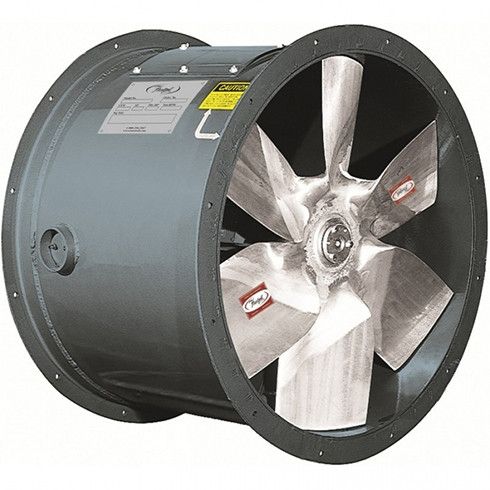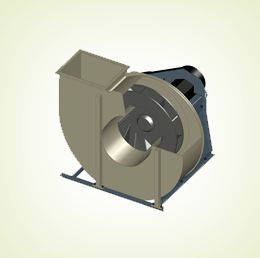The first and oldest option for an industrial fan is an axial fan. Here’s all you need to know about it.

Axial fans have been around forever. They’re the oldest design of a fan. These devices date back to the windmills designed by Persians in A.D. 500.
Engineers introduced the electrically powered fans to the public in the 1880s. These electric fans had the same design as the Persian windmills — an axial fan.
An axial fan is called “axial” because it has blades that rotate around a fixed axis. The fan is named for the direction of the airflow that it creates as it moves air.
The blades that rotate around the axis pull air in parallel to the axis and force it out in the opposite direction — still parallel to the axis.
Imagine a ceiling fan. There’s one fixed point in the ceiling that the fan blades rotate around. The fan draws air down from the ceiling, parallel to the axis, and forced straight down to the floor.
The airflow remains parallel to the axis of the fan for the entirety of the flow.
Axial fans don’t require a lot of power input in order to run. They move air at a high flow rate, meaning that they can move a lot of air. However, the airflow is low pressure.
Axial fans have a lot of uses, with most of them falling under the general-purpose category. Consider one anytime you need to move a large volume of air from one place to another.
Low-pressure, high-volume flow is great for cooling spaces, such as a home or office building. It’s also great for cooling equipment, like the computer you’re using right now.
An axial fan is used in condenser cooling for a refrigeration system. It can also make a great exhaust fan.
As more technology is incorporated into everyday products, axial fans become more and more common. They are now used in vending machines to cool the computers that allow for cashless payment options.
For non-ducted applications, this model is likely the solution you need for airflow. Axial fans move a lot of air from place to place when working against little pressure.
The alternative option for an industrial fan is a centrifugal fan. Check out some quick facts on centrifugal fans to see if it’s right for you.

The centrifugal fan was invented in 1556 to ventilate mines. It disappeared from history after that. The design made a resurgence in the early 1800s.
Centrifugal fans are sometimes called blowers because they create a high-pressure stream of air.
A centrifugal can contains blades mounted around a circular hub. The motion of the hub pulls air in and around the hub, increasing the air pressure as it goes.
These devices move air radially. The end result is that the air coming in is “bent” at a 90-degree angle before it is pushed out the other side of the fan.
Although they function similarly, centrifugal cans are not the same as air blowers. The latter creates higher pressure ratios than a centrifugal fan can achieve.
This type of fan is typically attached to a system of ducts or tubes. This increases pressure, creating high-pressure airflow.
Centrifugal fans usually have lower flow rates, move lesser volumes of air, and have steadier flow than axial fans. They also require a high power input to operate.
Anytime you need to move air through ductwork, you will want to consider a centrifugal fan.
When ductwork is involved, the ducts increase pressure due to increased airflow resistance. To overcome this higher pressure, you need a fan that can produce high-pressure flow. You need a centrifugal fan.
This makes centrifugal fans ideal for air conditioning or drying systems. They are also great for caustic or corrosive environments. They’re extremely durable fans that work great for pollution filtration systems.
With enclosed parts and particulate reduction capabilities, these devices are difficult to damage and extremely durable.
Here are some of the key points you need to remember when choosing between the two types of industrial fans.
All things being equal, an axial fan:
· Has a higher dynamic pressure
· Has a higher operating speed
· Has a higher peripheral speed
· Requires less power for operation
· Moves a larger volume of air
· Is typically smaller, lighter and less expensive
· Creates low-pressure airflow
All things being equal, a centrifugal fan:
· Is more energy efficient
· Is more durable and resistant to harsh environments
· Is less likely to overload due to non-overloading horsepower curves
· Creates high-pressure airflow
· Moves a smaller volume of air
· Requires more power for operation
· Works better with ductwork
· Can be equipped with self-cleaning characteristics